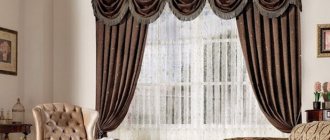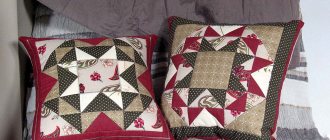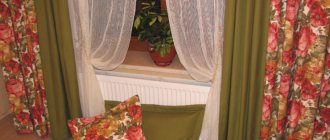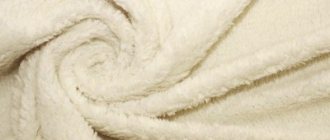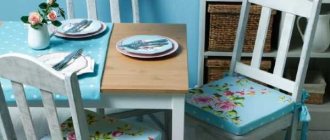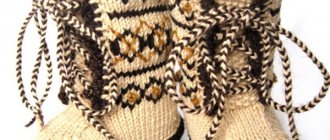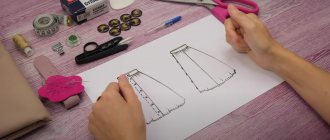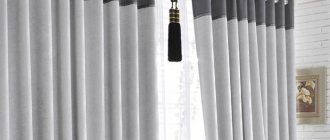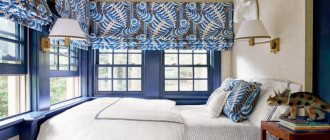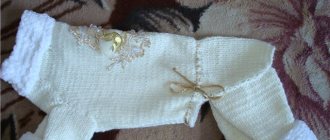A home is a place that you want to make cozy, beautiful and complete. But there will be no completeness if you leave the windows without curtains, and the curtains without lambrequins. They will give the interior special grace and beauty, and will also hide part of the wall between the window and the ceiling, replacing this not-so-pretty strip of wallpaper with elegant folds of fabric.
Swag or lambrequin
First, let's find out what a lambrequin and a swag are. A swag is a part of a soft lambrequin hanging horizontally from a window. The right color and texture will help decorate any room. Most often it is made in the form of a semicircle, consisting of beautiful folds.
There are so many options that it is not difficult to choose the one that suits the interior of the room.
You can make several swags in one lambrequin by placing them overlapping. Between them you can attach a decorative element: a tie or a mold.
A typical swag is cut at an angle of 45 degrees so that it takes on a semicircular shape.
Lambrequin is a decorative element that is used to decorate window openings. It can be combined with curtains and curtains.
Types of lambrequins
Once upon a time, when lambrequins had just appeared, they were made of wood, and their purpose was simple: to hide the cornice. No one was particularly sophisticated for this purpose, and the lambrequins were of the same type. Now, when they are made of fabric and serve mainly to decorate a room, add elegance and respectability to the interior and turn ordinary boring curtains into chic curtains, lambrequins are divided into four types.
- Classic lambrequin . Just a narrow strip of fabric, gathered into folds with a wide ribbon. There are three subtypes of the classic lambrequin: wavy, straight and arched. It depends on the design of the bottom edge. This lambrequin is good for those for whom something went wrong during the repair, and the window slope and cornice came out with defects. A classic lambrequin will hide them well, and it will simply look neat and beautiful.
- Hard lambrequin . As the name suggests, it holds its shape well. This happens due to the fact that it is made from a special, very dense fabric. As a result, the curtains on which such a lambrequin hangs look voluminous and majestic.
- Lambrequin with decorative inclusions . Chills, ties, flips, jabots and other pretentious elements - all this applies to lambrequins of this type. Lambrequins with decorative elements are a real space for your imagination and a great opportunity for self-expression, as well as giving the room a more interesting and, perhaps, even extravagant look. Of course, sewing them is not easy either; it’s better to start with something easier to perform.
- Combined lambrequin . This is the most complex type of lambrequins. It can combine elements of all three types: for example, when strips of fabric are pulled through holes in a rigid lambrequin, gathered into folds on the curtains (essentially a classic lambrequin).
There is also another division based on the components of the lambrequin:
- simple rectangular lambrequin,
- composite lambrequin made of geometric rectangular panels,
- composite lambrequin made of semicircles,
- a simple lambrequin of a fantasy shape.
When deciding on the type of lambrequins, you decide not only the design of the curtains, but also the appearance of the entire room. This seemingly small detail will determine the overall style, so you should think through everything carefully and only then take on the lambrequins.
Main types of lambrequin
The horizontal one is located in the upper section of the structure. It can be soft, made from curtain fabric. It is made into a fold or left as a straight linen with a figured bottom. It is decorated with any decorative details, and also elements for fastening (loop loops, ties) are attached to it.
A hard lambrequin is a product with a dense lining, which is glued with an iron (non-woven fabric, dublerin, bandeau, proklamin), as well as wood or plastic.
Combined - a combination of soft and hard components.
Figured - with a three-dimensional pattern. A type of three-dimensional decoration includes an openwork lambrequin, the pattern on which is burned out using a laser.
Openwork lambrequin
Openwork lambrequins have become a new trend in window design. Their height does not exceed 15-20 cm, so they are suitable for decoration in most apartments. Openwork lambrequins are a carved strip with a complex symmetrical or asymmetrical pattern.
For the material, plain felt of the same color as the curtains is most often used. Laser cutting is used in industrial production. Using adhesive tape, the openwork lambrequin is attached directly to the cornice.
With the help of such a lambrequin, even the usual window decoration with thick curtains and transparent tulle can add elegance and elegance. It is quite difficult to make it at home, but with a strong desire and the presence of a special soldering iron (burner) for fabric, it is still possible.
Curtains for the kitchen
The simplest curtains can be sewn for the kitchen . The main thing is that they are in harmony with the overall interior, that they are light, light, and “cheerful.”
The most practical material for the kitchen is polyester. Many housewives choose organza or tulle.
A fashionable novelty for decorating a kitchen window is the presence of blinds and the absence of curtains. This option is still unusual, but you can always add some zest to window decoration. Asymmetry is a great solution.
The solar curtain will fill the entire kitchen space with warmth. The easiest way to decorate a window:
- Attach the cornice.
- Cut two pieces of fabric and fold them on all sides.
- Sew loops to the top.
- Stretch a fabric of a different color from above, leaving a beautiful drapery on each side of the window.
DIY simple lambrequins
A simple lambrequin is a strip of fabric that is attached to or above the curtain rod, hiding it and the top of the curtain. Simple drapery can be made in the form of a gather or fold. The lower cut of the lambrequin can be simple - horizontal or figured - in the form of an arch.
For interiors in country or Provence style, which involve curtains made of natural linen or cotton, window decoration using a simple lambrequin remains relevant.
Stages of sewing an original curtain for the kitchen
See how to make a window decoration. Having mastered one type of sewing, you will be able to make all types of window decorations.
You will need:
- Main fabric;
- Fabric that acts as a lining;
- Curtain;
- One meter of cord.
Sewing instructions:
- Attach the curtain 10 cm above the window.
- Sew a cornice. Cut the main and lining fabric that will hold the folds.
- Fold the material right sides together, pin with needles, baste, stitch, leaving 35 cm at the top unstitched to turn inside out.
- Turn out, iron. Make folds.
- Fit the cornice to the curtain: center to center.
The second layer of the curtain is a cascade.
Cascade pattern.
A lambrequin made from a veil looks beautiful. Voile is a light transparent fabric that will decorate any window.
Take material of different shades and create a chic curtain.
- First, form the swag, placing it in the center.
- Then make a de jabot in a light shade (cut on the bias, complementing the swag).
- The detail for decoration is a mold, which is cut diagonally. The mold occupies the center of the structure.
Designs for a nursery or bedroom
A simple but very beautiful lambrequin called “Scarf”, complemented by formal curtains, can be placed in a bedroom or nursery.
See how to sew a product step by step:
- Let's determine the dimensions of the product. To prevent the swag or sagging from darkening the room, it should occupy no more than 6th part of the opening.
- Let's outline the height of the lambrequin;
- Fold the fabric in half, from its middle along the upper edge in both directions we mark ½ the length of the cornice, along the lower edge - the height of the sag;
- Connect the top and bottom points on each side, marking the line for sewing on the braid;
- Along the upper edge we will add the height of the folds to the width of the cornice. From the extreme point we draw a line down.
- Add allowances (2 cm each) to the resulting rectangle on the sides.
- We cut the fabric along the marked lines and bend it on all sides.
- Along the upper edge, equal to the length of the cornice and diagonal lines, we sew curtain braid.
Where the tape runs diagonally, we pull it together with the cords. Thus, we got a central swag with folds in a semicircle and coattails on the sides.
Tip: screed areas are decorated with decorative elements such as flowers and butterflies.
Patterns and necessary materials
What fabric is better to take for a lambrequin? In fact, many types of fabric are suitable for this purpose: taffeta, velvet, satin, ivy, cotton, linen, silk, polyester and much more. It all depends on the style in which you decorate the entire room, and it is the type of room itself. For example, velvet looks very rich and fits perfectly into the Baroque style. In addition, it holds its shape perfectly due to its density. It is perfect for decorating a living room. And polyester is often used to decorate kitchen windows, where practicality and the possibility of easy cleaning play a major role. Cotton , beautiful silk and linen are also practical , which are easy to wash, protect well from sunlight, are hygroscopic and hypoallergenic.
Light fabrics will add a certain lightness, airiness and elegance to the entire interior. For example, silk looks very good - the curtains will look like they are flying, like in a castle in the air. Heavy and dense fabrics, on the contrary, will give the curtains a certain monumentality and respectability, but at the same time elegance.
In addition to fabric, you will need thread , pins , ribbons and decorative cords . In addition, if you are making a solid lambrequin, in addition to the fabric you will need a special interlining , which is used to glue the fabric to maintain the given shape.
When choosing a pattern, you should be guided by your sewing skills and abilities. You shouldn’t immediately take on something complicated if you haven’t held a needle in your hands for several years.
How to decorate a window in the living room
Guests are most often invited to the living room. Where do guests' eyes go first? Of course on the window! Therefore, they try to decorate the windows in this room with beautiful curtains made of expensive fabric. Velvet is considered the most solemn and luxurious fabric.
Velvet curtains are complemented with tassels, fringe, and elegant braid.
It is best to hang velvet products in a living room, the interior of which is made in a classic style. The splendor of luxurious material will look good in a Rococo, Empire, Baroque interior, as well as next to a forged or carved wooden cornice.
How to work with velvet:
- Before cutting, carry out a wet-heat treatment to straighten the material.
- It should be cut in the direction of the pile from bottom to top so that the finished shade is deep and luxurious.
- When sewing, it is better to use silk threads.
- Make seams along the pile.
Velvet products love space, so they are hung only in a large living room. They will make a small room even smaller.
Lambrequin: past and present
Lambrequins were historically designed to hide the cornice. These were wooden carved structures, richly decorated, which created a luxurious window frame in combination with expensive draperies.
And if classic soft lambrequins with multi-layer draperies are becoming a thing of the past, remaining only in the design of theaters, museums and other public institutions, then new types of lambrequins, on the contrary, are becoming fashionable.
Lambrequins are not suitable for all rooms. Regardless of the interior style and curtain fabric, a complex lambrequin attracts attention, thereby drawing the eye to the ceiling. For rooms with low ceilings (less than 2.7 m) this design is not suitable, because... visually weighs down the window, making it squat, which makes the ceiling seem even lower.
How to quickly update your interior
If you are a little tired of the curtains, hang other curtains on the windows or simply make other curtains and that’s it, the interior has been successfully updated.
Folds
Curtains with folds look beautiful. You can achieve even folds using curtain tape. First, you need to attach a braid or lace to the tape, with a certain step.
Moreover, you need to do this by making precise distances to ensure uniform folds. Then stitch the tape to the panel.
If the tape is narrow, one line is enough. The wide ribbon is sewn in two lines, then you need to pull the lace and pull it off.
Buffs
It seems that it is impossible to sew a lambrequin with puffs without experience. But let's try.
- First, let's process the sections of the panel.
- Then we sew the puff tape with the top seam to the top of the fabric.
- We step back and sew on the curtain tape.
- The result was puffs in the form of a convexity.
- Let's pull the laces from the curtain tapes and get beautiful folds.
The “reaper” puffs look original.
Shell
A shell or fan is a great option for an update.
Patterns for making “shell” swag.
To give your living room a more formal look, sew curtains with fringes.
Fringe can be sewn on the bottom of the product or decorated with swags.
Braid
Curtains with braid will make the window more elegant and the atmosphere in the room - cozy.
Design and drawings of curtains with lambrequins
Openwork
Lambrequins can be made using frame technology with a laser pattern or soft, made of felt. The smaller the window size, the simpler the drawing should be.
If the window is large, you can use a wide lambrequin. Plain awnings and colored curtains look comfortable. The option is universal and suitable for any window.
Photos of curtains with openwork lambrequins for the hall can be seen below.
Asymmetry
Asymmetry involves draping on only one side. This is true if the window is small and does not allow for complete decoration.
In addition, highlighting sometimes covers part of the window.
Buffs
Solution for small windows. They are suitable if you need to create drapery lambrequins in a narrow or low window. Puffs are universal, suitable for creating any type of drapery, like braiding or a balloon.
Fringe
Fringe is a type of lambrequin decor that significantly modifies the drapery method.
Such models can be additionally decorated with beads or glass beads.
Fringe is appropriate in large rooms where the interior is entirely built in classicism, baroque, rococo, and new designs of the era of enlightenment.
This technology produces hard and soft models. Lambrequins with fringe for the hall can be seen in the photo below.
Simple
The most modern methods of drapery, which will allow you to decorate not only the classic style, but also modern, postmodern, loft, and hi-tech.
A simple method does not overload the interior, making it relaxing and peaceful. For this, narrow, plain lambrequins are used, thrown over the cornice.
With flowers
It is important to pay attention to the colors of curtains and design. If the entire interior is made in light colors, then dark ones are suitable for lambrequins. As a design, flowers are universal and can visually change the size of a room.
In small studios, large flowers would be appropriate. To further enlarge a large living room, a small pattern is suitable.
Two-color
A popular option is complementary colors. Contrast allows you to highlight the design against the background and make it more expressive, emphasizing the main tone of the interior.
Arched curtain
- An arched curtain is easy to sew and looks fresh and original.
- Take a piece of fabric, the height of which is equal to the length of the curtain + allowances, and the width is equal to the length of the cornice + allowance for gathering: (can be 2 or 3 lengths of the cornice).
- Next, fold the canvas in half lengthwise, cut out an arch whose width is equal to a third of the width of the window.
- You can sew ruffles and braid to the sections, and sew curtain tape on top.
- Then you need to tighten the canvas to the desired size.
- The top of the curtain can be decorated with an organza chill mold.
Dear friends, knowing how to sew curtains with a lambrequin will help you make your interior something that no one else will have. Creative success!
With ruffles
Now check out the master class on making your own lambrequin with ruffles.
A lambrequin with ruffles can decorate any, even the simplest curtain made from a plain veil. It consists of two panels of different colors, one of which will act as a lambrequin, and the second as a decorative “tie”.
Despite the apparent complexity, sewing such a lambrequin is extremely simple, and even a novice seamstress can handle it. The width of the lambrequin, which will be discussed below, corresponds to the length of the cornice - 1.8 m. Fastening on the cornice is using eyelets.
To work you will need:
- a yellow and white veil of length corresponding to the length of the cornice, taking into account the volume of folds. In this case, the length of the yellow veil will be 4.04 m and the width will be 0.45 m. The length of the white veil will be 2.02 m with a width of 0.9-1 m, depending on the selected height of this part;
- bias binding 1.5-2 m long;
- eyelets (11 pcs.).
Two patterns are made on paper: for a yellow veil, a rectangle measuring 4.04 X 0.45 m, and for a white veil, a polygon with sides 2.02 x 0.9 (1.0) x 0.45 m. The patterns are transferred to fabric, and then the parts are cut out.
The next step in the step-by-step instructions for making a lambrequin with your own hands is finishing the parts along the edge with bias tape. In this case, the upper cut is not processed.
The yellow and white veil is folded face up on a flat surface.
The upper sections are combined so that the panel of the white veil is in the side of the yellow veil. The parts are stitched along the top edge.
The top edge of the lambrequin is processed using an overlocker or a zigzag stitch on a regular sewing machine. Then the top edge is folded 5 cm to the wrong side and stitched.
The product is ironed, then markings are made on it for eyelets. To do this, the eyelets are laid out on the fabric at a distance of 1 cm from the top edge and 40 cm from one another.
The inner circumference of each eyelet is outlined with a pencil, and holes are cut into the fabric into which the eyelets snap into place.
The bias tape is folded in half lengthwise and stitched. From it you should cut 11 blanks for ties that will support the lambrequin. Their length should be determined based on the actual proportions of the window.
To prevent the fabric from fraying, the ends of the ties need to be scorched over a candle.
Pieces of bias tape are threaded through the eyelets and tied with a loose loop on the cornice.
The loops must be made the same length. The folds are straightened so that there is an equal distance between them.
Watch the video “Master class on sewing a lambrequin” to learn how to make a product with ruffles:
